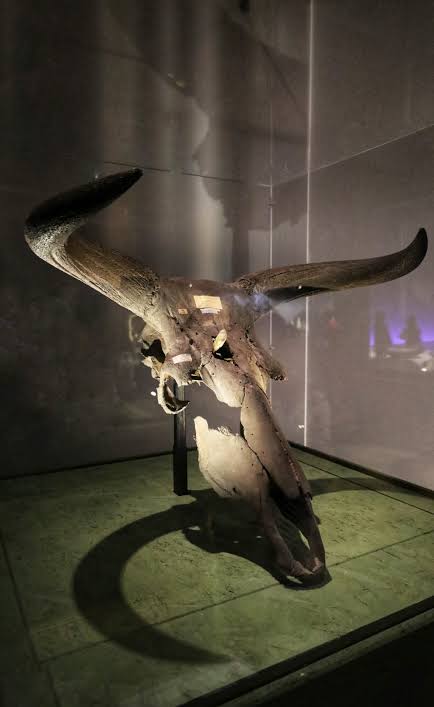[GUEST ACCESS MODE: Data is scrambled or limited to provide examples. Make requests using your API key to unlock full data. Check https://lunarcrush.ai/auth for authentication information.]  ArchaeoHistories [@histories_arch](/creator/twitter/histories_arch) on x 233.1K followers Created: 2025-07-19 08:04:17 UTC The prehistoric auroch skull with an embedded Neolithic axehead, discovered in Cambridgeshire and dating from 3370-2800 BC, represents a compelling piece of evidence for the interactions between early humans and extinct megafauna. Found in Burwell Fen in 1863, this artifact features the skull of an auroch (Bos primigenius), the wild ancestor of modern cattle, with a Neolithic stone axehead firmly lodged in its frontal bone. The authenticity of the embedded axehead, initially questioned, was later confirmed by prominent geologists, cementing its status as a genuine record of a prehistoric encounter. This remarkable find offers significant insights into Neolithic hunting practices and the efficacy of their stone tools. The presence of the axehead suggests a direct and forceful, likely fatal, blow delivered to the formidable auroch by early human hunters. Beyond the practicalities of the hunt, the artifact also sheds light on the complex relationship between Neolithic societies and the wild animals they encountered. Successfully hunting such a powerful creature would have been a testament to the skill and cooperative effort of the hunters, potentially holding considerable symbolic or ritualistic importance within their community. Today, the prehistoric auroch skull with its embedded Neolithic axehead is a prized possession of the Sedgwick Museum of Earth Sciences in Cambridge. It continues to serve as a tangible link to a bygone era, providing valuable data for archaeologists and paleontologists studying the subsistence strategies, technological capabilities, and cultural practices of human populations during the Neolithic period. #archaeohistories  XXXXX engagements  **Related Topics** [Engagements](/topic/interactions) [Post Link](https://x.com/histories_arch/status/1946481202400993441)
[GUEST ACCESS MODE: Data is scrambled or limited to provide examples. Make requests using your API key to unlock full data. Check https://lunarcrush.ai/auth for authentication information.]
 ArchaeoHistories @histories_arch on x 233.1K followers
Created: 2025-07-19 08:04:17 UTC
ArchaeoHistories @histories_arch on x 233.1K followers
Created: 2025-07-19 08:04:17 UTC
The prehistoric auroch skull with an embedded Neolithic axehead, discovered in Cambridgeshire and dating from 3370-2800 BC, represents a compelling piece of evidence for the interactions between early humans and extinct megafauna. Found in Burwell Fen in 1863, this artifact features the skull of an auroch (Bos primigenius), the wild ancestor of modern cattle, with a Neolithic stone axehead firmly lodged in its frontal bone. The authenticity of the embedded axehead, initially questioned, was later confirmed by prominent geologists, cementing its status as a genuine record of a prehistoric encounter.
This remarkable find offers significant insights into Neolithic hunting practices and the efficacy of their stone tools. The presence of the axehead suggests a direct and forceful, likely fatal, blow delivered to the formidable auroch by early human hunters. Beyond the practicalities of the hunt, the artifact also sheds light on the complex relationship between Neolithic societies and the wild animals they encountered. Successfully hunting such a powerful creature would have been a testament to the skill and cooperative effort of the hunters, potentially holding considerable symbolic or ritualistic importance within their community.
Today, the prehistoric auroch skull with its embedded Neolithic axehead is a prized possession of the Sedgwick Museum of Earth Sciences in Cambridge. It continues to serve as a tangible link to a bygone era, providing valuable data for archaeologists and paleontologists studying the subsistence strategies, technological capabilities, and cultural practices of human populations during the Neolithic period.
#archaeohistories

XXXXX engagements
Related Topics Engagements